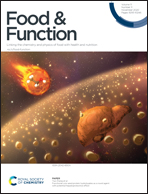Structural characterization, erythrocyte protection, and antifatigue effect of antioxidant collagen peptides from tilapia (Oreochromis nilotica L.) skin
Abstract
Tilapia (Oreochromis nilotica L.) skin collagen is a meritorious commercial resource to be exploited. The purpose of this study was to obtain, evaluate, and characterize tilapia skin collagen-derived antioxidant hydrolysates (TSCP). AAPH-induced erythrocyte hemolysis assay and antifatigue test in mice were implemented. It was indicated that TSCP treatment at 1 mg mL−1 could effectively attenuate AAPH-induced erythrocyte hemolysis rate from 56.35 ± 2.46% to 18.78 ± 2.48% (p < 0.01). A 2.5 mg/(10 g d) dose of TSCP intragastric administration could observably prolong the exhaustive swimming time of the loaded mice and its mechanism was multiple, including the decrease in the levels of serum lactic acid, serum urea nitrogen, and creatine kinase activity, thus improving the contents of liver and muscle glycogen and endogenous SOD activity. Five oligopeptides from the antioxidant fraction were identified as Gly-Hyp, Glu-Asp, Asp-Hyp-Gly, Glu-Pro-Pro-Phe, and Lys-Pro-Phe-Gly-Ser-Gly-Ala-Thr and then synthesized. Among them, the octapeptide exhibited the strongest antioxidant capacity. Therefore, tilapia skin-derived collagen is a meritorious edible resource for producing commercial functional foods, thus helping to scavenge radicals, protecting erythrocytes, and further resisting fatigue.



 Please wait while we load your content...
Please wait while we load your content...